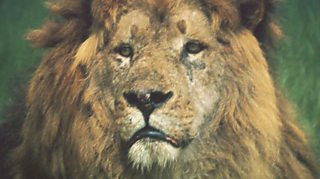Nine roar-some facts about lions
The all-new, live-action adaption of Disney’s The Lion King is roaring into cinemas and it’s got us all talking about the magnificent big cat that takes centre stage.
Here are nine ext-roar-dinary facts about everyone’s favourite oversized feline, the lion.

1. A lion’s roar can be heard five miles away
The lion has the loudest roar of all the big cats. It’s so loud it can reach 114 decibels (at a distance of around one metre) and can be heard from as far away as five miles.
This volume is all to do with the shape of the cat’s larynx. Most animals have triangular vocal cords but a lion’s are square and flat, which allows them to respond more easily to air passing through. This means a louder roar with less effort.
-
![]()
Life on Earth: The Hunters and the Hunted
The evolution of the grazing animals and their predators.
-
![]()
Natural Histories
Nature that has had a profound impact on human culture and society across history.
2. A male lion can eat over 40kg of meat in a day
A female lion needs 5 kg and a male lion around 7 kg of meat a day, and studies of the animal in the wild show that their average intake is between 8 kg and 9 kg per day. However, a lioness can eat over 25 kg and a male may eat as much as 40 kg in a single sitting. That’s the equivalent of 40 large packets of mince beef.
3. Lions can run as fast as 50mph
The lion is the second fastest wild cat (after the Cheetah) with a top running speed of around 50mph. However, the heart of a lioness (who does most of the hunting) only accounts for around 0.57 percent of her body weight, so stamina is not her strong suit. This top speed is for short distances only so the hunter needs to be close to his or her prey before launching an attack.
4. The darker a lion’s mane, the older he is
A good way to guess a male lion’s age is from inspecting the darkness of his mane (from a distance of course). The darker the mane, the older the lion.
It’s also a sign of high levels of testosterone, and therefore strength, so a black-maned lion is likely to attract more females.
Are Disney re-makes worth it?

What do the audience make of it, and will they be buying tickets to go see them?
5. The lion is the only cat with a tasselled tail
The lion is the only member of the cat family to have a tassel at the end of its tail. This appendage is a crucial communication tool, used for signalling to other members of the pride. It can be used to give directions and commands and even for flirting.
6. The oldest lion on record was nearly 29 years old
The average lifespan of a lion is 13 years. However, in captivity – where they aren’t reliant on their strength and hunting abilities to survive – they can live for a lot longer. The oldest recorded age of a lion was almost 29 years.
7. A lion's night vision is six times better than yours
In the daytime a lion’s vision may not be all that different from a human’s, and fewer cone cells in the retina means they see less colour, but it’s at night that their eyesight really comes into its own.
A lion’s eye is packed with photoreceptor cells to pick up light as it enters, and then a reflective membrane behind the retina reflects any light right back on to these light-sensitive cells. They also have white strips under their eyes to help reflect as much light as possible into the pupils. All this means that a lion only needs one sixth of the light that humans need to see in. This spectacular night vision makes them a mean opponent for prey during the hours of darkness.
Meet a modern day lion trainer

Mike Williams talks to a modern day lion trainer with the biggest animal act in the world.
8. A lion can hear prey from a mile away
A lion has incredible hearing, helped by swivelling ears that adjust to the direction that sound is coming from. Their sensitive hearing means they are able to stalk prey when it’s obscured by dense vegetation and detect their next meal when it’s as far as a mile away.
The African lion population has plummeted by over 40% over the last three generations.
9. There may be as few as 20,000 lions left in the wild
The African lion population has undergone catastrophic declines, plummeting by over 40% over the last three generations. This is due to a loss of natural habitat and prey, and the devastating impact of hunting and poaching. With the number left in the wild estimated at between 20,000 and 39,000, this majestic creature is now officially classified as ‘vulnerable’.
More from the Βι¶ΉΤΌΕΔ
-
![]()
Life on Earth: The Hunters and the Hunted
David Attenborough on the evolution of the grazing animals and their predators including the jaguar, the lion and the hyena.
-
![]()
How it feels when a male lion roars nearby
Wildlife filmmaker Adam Chapman describes the feeling of hearing a nearby lion roaring.
-
![]()
Symbolism of the Lion of Judah
Dr Shawn Sobers discusses the lion as a symbol of power in Ethiopian and Rastafarian culture.
-
![]()
How the lions of Trafalgar Square were made
Rosie Broadly from the National Portrait Gallery talks to Brett Westwood about the design and manufacture of the 'sphynx-like' bronze lions.





